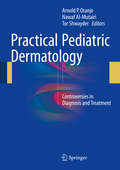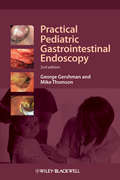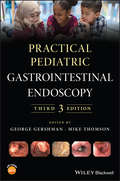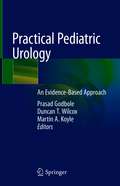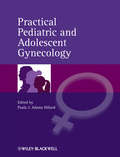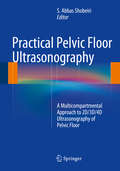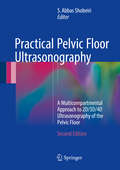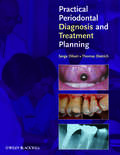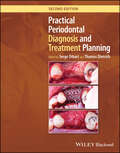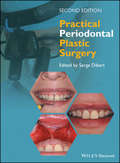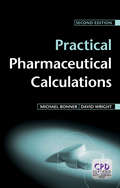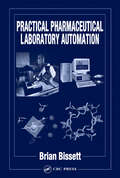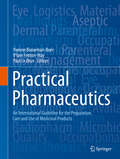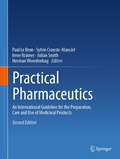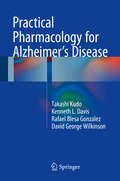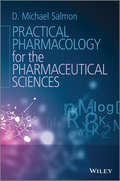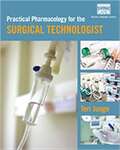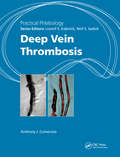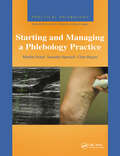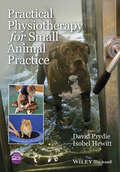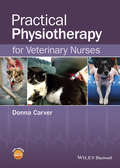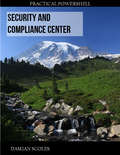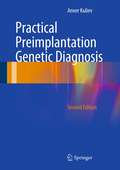- Table View
- List View
Practical Pediatric Cardiology
by Alan G. Magee Jan Till Anna N. SealeHeart disease in children has a number of diagnostic traps for the unwary, and all of us involved in the specialty have been caught at one time or another. For example, it is sometimes very difficult to differentiate between respiratory and cardiac disease in infants and between neurological and cardiac conditions in older children, and the consequences of taking the wrong path can be significant. This book is a collection of cases highlighting situations which can ensnare even the best cardiologist. Although they illustrate the importance of taking a good history and performing a thorough examination, the most important lesson is learning to keep an open mind and develop the ability to think laterally. As clinicians we need to have the confidence to make a decision for our patients but also the humility to be able to acknowledge that we don't always get it right first time, and it is imperative that we learn from the experience. We hope the reader will find these short chapters interesting and while they are not evidence-based medicine in the true sense, they do represent a wide range of clinical experience from which we can all learn.
Practical Pediatric Dermatology
by Arnold P. Oranje Nawaf Al-Mutairi Tor ShwayderThis book presents a selection of controversial issues of practical importance in pediatric dermatology with the aim of enabling the reader to adopt a well-balanced and evidence-based approach to the management of dermatological disorders encountered during childhood. It is not, therefore, structured according to a basic disease classification; rather it addresses a series of dilemmas in the diagnosis and treatment of a wide range of conditions, including inflammatory disorders, tumors, immune and autoimmune disorders. In addition to areas of debate in the management of individual conditions, controversies in the use of particular types of treatment, for example retinoids, cyclosporin, acyclovir, and laser therapy, are considered and relevant psychological aspects are discussed. Practical Pediatric Dermatology will assist pediatricians and dermatologists in decision making during daily clinical practice.
Practical Pediatric Gastrointestinal Endoscopy
by George Gershman Mike ThomsonThis practical step-by-step guide to performing GI endoscopy safely and effectively in children covers the use of endoscopy as both a diagnostic and a therapeutic modality. Now with an entirely new section focusing on advanced endoscopic techniques, such as such as pancreatic cysto-gastrostomy, confocal endo microscopy, and single balloon enteroscopy, the new edition gives trainees and practitioners access to the most recent, as well as the most dependable, information.
Practical Pediatric Gastrointestinal Endoscopy
by George Gershman Mike ThomsonThe reference text for all those practicing diagnostic and therapeutic pediatric endoscopy – trainees, trainers, specialist endoscopists, gastroenterologists and hepatologists alike. Practical Pediatric Gastrointestinal Endoscopy, 3rd Edition provides a comprehensive and up-to-date exploration for the performance of endoscopy in infants, children and young adults. Written in the form of a complete “how to” manual and filled with step-by-step instructions, this book seeks to bring newcomers to the field of pediatric gastrointestinal endoscopy quickly up to speed. The book is also highly useful for experienced specialist endoscopists and gastroenterologists to brush up on best practice in standard techniques and explore advanced topics in the field. Practical Pediatric Gastrointestinal Endoscopy highlights the substantial and important differences between performing an endoscopy on a mature adult and performing one in a pediatric patient. The differences discussed include: GI pathology Subtleties of diagnostic technique specific to children Application of therapeutic endoscopy to specifically pediatric scenarios Anesthesia and sedation Training and skill maintenance Sophisticated endoscopic techniques adapted from adult endoscopy to children and those techniques specifically orientated to problems and diseases mainly encountered in childhood This guide is becoming an essential companion for those of us providing diagnostic and therapeutic endoscopy for children in the world today and opens the door to future possibilities in this ever-evolving field.
Practical Pediatric Urology: An Evidence-Based Approach
by Duncan T. Wilcox Martin A. Koyle Prasad GodboleThis book provides a case based approach to the problems faced within pediatric urology and an evidence based approach to their solutions. Chapters on urodynamics, external genitalia, the upper urinary tract, the lower urinary tract, and office pediatric urology are included. Practical Pediatric Urology aims to utilise real life scenarios to improve data analysis, diagnosis, and treatment decisions within clinical settings. Key learning objectives are included to enable medical professionals to assimilate, synthesise, and formulate a management plan for pediatric urological conditions encountered in clinical practice in a safe and evidence based approach. This book is relevant to pediatricians, pediatric surgeons, pediatric urologists and adult urologists who undertake some pediatric urology practice.
Practical Pediatric and Adolescent Gynecology
by Paula J. HillardPediatric and Adolescent Gynecology Edited byPaula J Adams Hillard, MD, Department of Obstetrics and Gynecology, Stanford University School of Medicine, Stanford, CA, USA The gynecologic needs of younger patients are variable and complexClinicians are often uncomfortable with the gynecologic concerns of young girls and developing women. How can I put the patient at ease? What are the rights of the patient and her parents? How do I ask the questions in a way that allows her to trust me so that I can better understand her medical and social situation? In Pediatric and Adolescent Gynecology, Dr Hillard has designed a new textbook that puts the patient at the center. It follows the patient's life and her changing needs as she matures. An emphasis on effective, patient-friendly encounters is the prelude to a sensitive clinical approach to intimate, potentially awkward, clinical challenges. Short, practical chapters provide guidance on the issues rather than an academic treatise. This 'in the office' guide to effective patient care is informed by evidence-based practice and backed by a wealth of practical features: Algorithms and guidelines to most effective approaches'Tips and Tricks' boxes so you can improve you clinical outcomes'Caution' warning boxes so you can avoid complications 'Science Revisited' boxes give a quick reminder of the basic science principles Dr Hillard has assembled an expert group of authors to provide straightforward guidance to caring for and reassuring your younger patients and their parents. If you provide clinical care to girls and young women then Pediatric and Adolescent Gynecology is designed for you. Titles of related interestContraceptionShoupe (ed); ISBN 978-1-4443-3351-0 Sexually Transmitted DiseasesBeigi (ed); ISBN: 978-0-470-65835-2 Disorders of MenstruationMarshburn and Hurst (eds); ISBN 978-1-4443-3277-3
Practical Pelvic Floor Ultrasonography
by S. Abbas ShobeiriPractical Pelvic Floor Ultrasonography: A Multicompartmental Approach to 2D/3D/4D Ultrasonography of Pelvic Floor provides an introduction to pelvic floor imaging, as well as a resource to be used during initial and more advanced practice. The book helps readers gain competence in performing 2D/3D/4D transperineal, and 2D/3D endovaginal / endoanal ultrasound evaluation of the pelvic floor, including anal sphincter and levator ani complex. The text also shows interested clinicians how to obtain optimal images of pelvic floor muscles and organs, how to obtain useful images of the anal canal, levator ani complex, urethra, and how to interpret clinical implications of alterations of the anatomy. In addition, emerging techniques of "dynamic" pelvic floor ultrasound and 3D/4D ultrasound are introduced through step by step protocols that are aimed at optimizing sonographic images. Written entirely by experts in their fields, Practical Pelvic Floor Ultrasonography: A Multicompartmental Approach to 2D/3D/4D Ultrasonography of Pelvic Floor is a comprehensive resource that will be of great value to urogynecologists, colorectal surgeons, obstetrician and gynecologists, female urologists, ultrasonographers, radiologists, physiotherapists, as well as fellows in urogynecology and colorectal surgery.
Practical Pelvic Floor Ultrasonography
by S. Abbas ShobeiriPractical Pelvic Floor Ultrasonography: A Multicompartmental Approach to 2D/3D/4D Ultrasonography of Pelvic Floor provides an introduction to pelvic floor imaging, as well as a resource to be used during initial and more advanced practice. The book helps readers gain competence in performing 2D/3D/4D transperineal, and 2D/3D endovaginal / endoanal ultrasound evaluation of the pelvic floor, including anal sphincter and levator ani complex. The text also shows interested clinicians how to obtain optimal images of pelvic floor muscles and organs, how to obtain useful images of the anal canal, levator ani complex, urethra, and how to interpret clinical implications of alterations of the anatomy. In addition, emerging techniques of "dynamic" pelvic floor ultrasound and 3D/4D ultrasound are introduced through step by step protocols that are aimed at optimizing sonographic images. Written entirely by experts in their fields, Practical Pelvic Floor Ultrasonography: A Multicompartmental Approach to 2D/3D/4D Ultrasonography of Pelvic Floor is a comprehensive resource that will be of great value to urogynecologists, colorectal surgeons, obstetrician and gynecologists, female urologists, ultrasonographers, radiologists, physiotherapists, as well as fellows in urogynecology and colorectal surgery.
Practical Periodontal Diagnosis and Treatment Planning
by Serge DibartPractical Periodontal Diagnosis and Treatment Planning offers its readers a step-by-step guide to diagnosing and planning treatment for periodontal patients through the latest evidence-based protocols. It summarizes the available scientific evidence for efficacy and effectiveness and links it to everyday clinical practice in a concise, user-friendly manner. Practical Periodontal Diagnosis and Treatment Planning begins with the basics of periodontal diagnosis, following the latest classification by the AAP. Modifiable and non-modifiable risk factors are assessed in detail, emphasizing the treatment planning intricacies associated with each one. The book discusses all presentations of periodontal disease ranging from gingivitis to aggressive periodontitis, highlighting topics such as occlusion, scaling and root planning. The full range of treatment modalities are also presented, providing practical instruction for osseous resective surgery, regenerative and supportive periodontal therapy, and dental implant complication management. Designed to improve and expand the reader’s repertoire of clinical skills, Practical Periodontal Diagnosis and Treatment Planning provides comprehensive coverage of this core part of periodontal training in a concise, highly illustrated, step-by-step format.
Practical Periodontal Diagnosis and Treatment Planning
by Serge Dibart Thomas DietrichPractical Periodontal Diagnosis and Treatment Planning Understand periodontal diseases and their treatment with this practical guide Practical Periodontal Diagnosis and Treatment Planning, Second Edition provides a fully up-to-date guide to the latest techniques, both surgical and non-invasive, for minimizing the impact of periodontal conditions. The Second Edition has been updated to reflect the new periodontal disease classification, thoroughly explaining the staging and grading system, comparing the new system to previous system, and discussing how to use the classification in everyday clinical practice. This essential step-by-step guide to integrating digital technologies in surgical implant therapy and prosthetic rehabilitations offers a thorough understanding of the concept of facial sculpture to complement and enhance intra-oral rehabilitation. The book takes an evidence-based approach to diagnosis and treatment, incorporating significant research and clinical experience to best reflect the needs of both patients and clinicians. Lavishly illustrated and including three new chapters covering novel disease classifications and cutting-edge treatments, this updated reference helps to develop clinical skills. Practical Periodontal Diagnosis and Treatment Planning includes: Complete information on the new periodontal disease classification A digital workflow for a smooth intraoral rehabilitation Practical instructions for periodontal procedures such as osseous resective surgery, regenerative and supportive periodontal therapy, dental implant complication management, and more Analysis of the use of Botox and dermal fillers as an alternative to surgical treatment and enhancement of appearance concomitant with dental treatments Discussion of periodontal disease presentations including occlusion, scaling, and root planing Practical Periodontal Diagnosis and Treatment Planning, Second Edition is an essential guide for periodontists, oral surgeons, and advanced students in dentistry, periodontics, and oral hygiene.
Practical Periodontal Plastic Surgery
by Serge DibartPractical Periodontal Plastic Surgery, Second Edition builds on the success of the first edition to provide the qualified and trainee periodontist with an essential guide to the clinical requirements and step-by-step procedures of periodontal plastic surgery. Features additional clinical photographs to illustrate procedures Brings together periodontal and plastic surgery expertise Retains the popular step-by-step format for quick and clear reference
Practical Pharmaceutical Calculations (Radcliffe Ser.)
by David Wright Michael BonnerUnderstanding practical pharmaceutical calculations is essential for healthcare professionals. Even simple errors in calculation can have serious - and possibly fatal - consequences. Fully revised and updated, with entirely new chapters and a focus on basic arithmetic, this best-selling practical guide begins by explaining simple units of measurements and expressions of concentration, followed by demonstrations of how straight-forward calculations can be used to estimate individual patient dosages. At the end of each chapter there are self assessment calculations, with fully worked answers - ideal for revision and self-assessment. With the book and free downloads you can always have the guide on hand when you need it most.
Practical Pharmaceutical Laboratory Automation
by Brian D. BissettLaboratory automation is an increasingly important part of the job description of many laboratory scientists. Although many laboratory scientists understand the methods and principles involved in automation, most lack the necessary engineering and programming skills needed to successfully automate or interface equipment in the lab. A step-by-step,
Practical Pharmaceutics
by Yvonne Bouwman-Boer V'Iain Fenton-May Paul Le BrunThis book contains essential knowledge on the preparation, control, logistics, dispensing and use of medicines. It features chapters written by experienced pharmacists working in hospitals and academia throughout Europe, complete with practical examples as well as information on current EU-legislation. From prescription to production, from usage instructions to procurement and the impact of medicines on the environment, the book provides step-by-step coverage that will help a wide range of readers. It offers product knowledge for all pharmacists working directly with patients and it will enable them to make the appropriate medicine available, to store medicines properly, to adapt medicines if necessary and to dispense medicines with the appropriate information to inform patients and caregivers about product care and how to maintain their quality. This basic knowledge will also be of help to industrial pharmacists to remind and focus them on the application of the medicines manufactured. The basic and practical knowledge on the design, preparation and quality management of medicines can directly be applied by the pharmacists whose main duty is production in community and hospital pharmacies and industries. Undergraduate as well as graduate pharmacy students will find knowledge and backgrounds in a fully coherent way and fully supported with examples.
Practical Pharmaceutics: An International Guideline for the Preparation, Care and Use of Medicinal Products
by Julian Smith Paul Le Brun Herman Woerdenbag Sylvie Crauste-Manciet Irene KrämerPractical Pharmaceutics contains essential knowledge on the preparation, quality control, logistics, dispensing and use of medicines. It features chapters written by experienced pharmacists and scientists working in hospitals, academia and industry throughout Europe, including practical examples as well as information on current GMP and GMP-based guidelines and EU-legislation. In this second edition all chapters have been updated with numerous new as well as didactically revised illustrations and tables. A completely new chapter about therapeutic proteins and Advanced Therapy Medicinal Products was added. From prescription to production, from usage instructions to procurement and the impact of medicines on the environment, the book provides step-by-step coverage that will help a wide range of readers, students as well as professionals. It offers product knowledge for all pharmacists working directly with patients and it will enable them to make the required medicine available, to store medicines properly, to adapt medicines if necessary and to dispense medicines with the appropriate information for patients as well as caregivers about product care and how to maintain the quality of the product. The basic knowledge presented in the book will also be valuable for industrial pharmacists to remind and focus them on the application of the medicines manufactured. The basic and practical knowledge on the design, preparation and quality management of medicines can directly be applied by the pharmacists whose main duty is production in community and hospital pharmacies and in industry. Undergraduate as well as graduate pharmacy students will find knowledge presented in a coherent way and fully supported with relevant examples. Practical Pharmaceutics has become a reliable and recognised source for the acquisition of pharmaceutical-technological knowledge. The book is used in the curriculum of a number of international universities and schools of Pharmacy.
Practical Pharmacology for Alzheimer's Disease
by Takashi Kudo Kenneth L. Davis Rafael Blesa Gonzalez David George WilkinsonIn this book, the four leading experts on the ACE inhibitors donepezil, galantamine, and rivastigmine and the NMDA receptor antagonist memantine explain the practical pharmacology of these symptomatic drugs with the aim of providing a sound basis for their clinical use in patients with Alzheimer's disease. In addition, an introductory chapter considers the basic theory of pharmacology for Alzheimer's disease and the book closes with an overview of the ways in which symptomatic drugs for dementia are used. The wide acceptance of the amyloid cascade hypothesis has led to vigorous development of disease-modifying drugs for Alzheimer's disease, such as amyloid vaccinations and gamma- or beta-secretase inhibitors. The failure of clinical trials of these drugs to yield satisfactory results has, however, meant that for the time being patients continue to be treated only with symptomatic drugs. There is accordingly a need to become more proficient in the use of symptomatic medicines, and it is against the background of this quest that Practical Pharmacology for Alzheimer's Disease will be of wide interest.
Practical Pharmacology for the Pharmaceutical Sciences
by D. Michael SalmonPractical Pharmacology for the Pharmaceutical Sciences is a lab survival guide for those studying Pharmacology, providing hands-on advice on developing pharmacology laboratory and data handling skills. Suitable for both undergraduates and postgraduates, it focuses on laboratory techniques rather than computer-simulated data. It also guides the reader through the process of communicating experimental results in a variety of formats, including posters, oral presentations and project reports.Split into three main areas, the following topics are covered in detail: Preparation for Experimental PharmacologyLegal aspectsFundamentals of PharmacologyDefinitions, calculations and statisticsExperiments in PharmacologyMicrotitre-based techniques using isolated cellsIn vitro techniques using isolated tissues and organsBiochemical techniques using cell-free systemsCommunicating experimental resultsData presentationHow to write scientific reportsPharmacological literatureSupported with numerous questions throughout the text, as well as step by step instructions for practical experiments, this book presents an approach to learning pharmacology through an appreciation of authentic experimental data.
Practical Pharmacology for the Surgical Technologist (Mindtap Course List Ser.)
by Teri JungeKnow the critical facts about patient medications, their common uses, and the safety processes observed in surgical settings today with PRACTICAL PHARMACOLOGY FOR THE SURGICAL TECHNOLOGIST. Created with input from seasoned professionals and techs in training, this text focuses specifically on the needs of surgical technologists, complies with all requirements from the Core Curriculum for Surgical Technology, 6th Edition. Handy features throughout the chapters highlight must-know, core curriculum content, while critical thinking and review questions give you practice thinking on your feet. Learning on the go is easier than ever with available MindTap e-resources, making this text an ideal resource when preparing for the Certified Surgical Technologist (CST) exam).
Practical Phlebology: Deep Vein Thrombosis (Practical Phlebology)
by Anthony J. ComerotaThe latest volume in the Practical Phlebology series, Deep Vein Thrombosis provides trainee and practicing physicians with the ideal illustrative guide to the etiology, diagnosis, and management of deep vein thrombosis (DVT). Based on peer-reviewed literature and quality clinical trials, the book is also an essential resource for academicians. Topi
Practical Phlebology: Starting and Managing a Phlebology Practice (Practical Phlebology)
by Marlin Schul Saundra Spruiell Clint HayesStudies routinely report a prevalence of venous disease of twenty percent or higher among western industrialized countries, and it is predicted that numbers will rise even higher in industrialized and obese populations. The management of venous disease has moved from the hospital and institutional setting to one that operates predominantly in an outpatient arena. These settings are often far more representative of a cosmetic surgery or dermatology practice, targeted to optimize the patient experience. Those who have adopted endovenous procedures in the typical hospital environment often meet obstacles that limit their ability to expand phlebology care. Practical Phlebology: Starting and Managing a Phlebology Practice provides a practical yet effective framework for transitioning an existing hospital-based practice to the outpatient arena.Some of the questions tackled by this manual include: Where can I acquire the necessary training and education? What equipment is required, and where might I find it? What are my start-up costs, and will I need a loan? What personnel are needed, and how do I identify the best candidates? What is the best way to market my practice? How much will I spend and how effective will a campaign be? How do insurers view procedures for varicose veins? How will I be paid? These questions and many more are outlined in detail. The book provides examples that help readers take steps towards creating a successful phlebology practice.There are many ways to develop and manage a practice and the authors recognize that not all strategies work in all markets. Despite differences from country to country, this text shares sound principles that, when implemented, should enhance an existing system and help to improve patient outcomes.
Practical Physiotherapy for Small Animal Practice
by David Prydie Isobel HewittPractical Physiotherapy for Small Animal Practice provides a concise and accessible introduction to physiotherapy that demonstrates its benefits to both veterinary patients and practitioners. One of the fastest growing specialties in veterinary medicine, this book will help you to successfully introduce physiotherapy into your practice improving rehabilitation and recovery of dogs and cats. Key features: Covers an array of different treatments and techniques, such as manual therapies, therapeutic exercise, electrotherapy, and hydrotherapy Includes practical advice on selecting equipment, examinations, treatment protocols, and charging Offers strategies for introducing physiotherapy into the practice schedule, including space and staffing requirements Companion website provides over 50 printable client education handouts for download
Practical Physiotherapy for Veterinary Nurses
by Donna CarverReflecting a rapidly growing area of interest in veterinary practice, this practical, pocket-sized guide to small animal physiotherapy has been designed for quick reference, providing the ideal guide for busy practice veterinary nurses when they really need it. Reflects the need for a text in this rapidly growing area of interest, providing the first on this topic for veterinary nurses Designed in a pocket-sized format so that VNs can carry it around for quick reference The author has ideal experience for this field, having worked as both a veterinary nurse and an animal physiotherapist This book is accompanied by a companion website which contains videos and self-test questions and answers
Practical PowerShell Security and Compliance Center: Get to grips with effectively managing the Security and Compliance Center with PowerShell, 2nd Edition
by Damian ScolesLearn all the latest practices to build and enhance your PowerShell scripts and manage the Security and Compliance Center easily and efficiently Key Features Gather the latest information and new cmdlets to get started with PowerShell Discover innovative ways to construct useful scripts Learn how to manage SCC with PowerShell through real-world scenarios Book Description PowerShell is an integral part of Office 365. This updated edition shares tips, tricks, new cmdlets, and best practices for using PowerShell with the Security and Compliance Center. The book starts by covering the basic tools of PowerShell, such as PowerShell ISE and PowerShell repositories, and then goes on to teach you how to connect to the SCC using multi-factor authentication. You will manage role groups to layer security, before exploring the importance of information barriers. As you progress, you will orchestrate insider risk policies to protect your organization from malicious users with access to sensitive data. Next, the book will show you how to manage various devices using tenant policies and device access rules. Later chapters will delve into various reporting methods and explore options for troubleshooting scripts and best practices to produce better scripts. The book concludes with an overview of Microsoft Secure Score to help you measure your organization's security posture. By the end of this book, you'll have the latest information and new cmdlets to confidently manage the Security and Compliance Center (SCC) with PowerShell. What you will learn Enhance the script, test it, and move it into production Make your PowerShell scripts more usable and accessible Study directory synchronization and its applications Explore layers of security that prevent unauthorized access Use PowerShell to implement Data Loss Prevention (DLP) Understand compliance and how it can be managed with PowerShell Who this book is for If you are already managing Exchange and have some PowerShell experience, then this book is for you. Professionals who want to gain more proficiency in PowerShell but are unsure of how to approach it will also find this book useful. To get the most out of this book, you must have sufficient experience of working in PowerShell as the book is not a beginner's guide to PowerShell.
Practical Preimplantation Genetic Diagnosis
by Anver KulievAlthough treatment remains the major goal in the control of genetic disease, this is not yet a reality for most inherited conditions. In the absence of radical treatment, preimplantation genetic diagnosis (PGD) offers the answer to the control of these inherited conditions by predicting reproductive outcome. PGD is now entering its third decade as an established procedure for genetic and assisted reproduction practices, with new and exciting developments changing the whole concept of prevention of congenital disorders. The availability of practical experience from tens of thousands of PGD cases makes it necessary to update the current information on its accuracy, reliability and safety. The Second Edition of this successful book updates the progress in prevention of genetic disorders to demonstrate the important place of PGD in primary preventive measures and its increasing role in providing the whole range of reproduction options to couples at risk. In addition, it provides an extensive review of the most recent developments within the field of PGD including, PGD for expanding indications such as de novo mutations, cancers, inherited cardiac diseases and combined PGD for single gene disorders, HLA typing and 24 chromosome testing in patients of advance reproductive age. This practical book is vital for all practitioners within the field of fertility, reproductive medicine and medical genetics. It will also be useful for those responsible for planning and organizing PGD services and provides a working manual for the establishment and performance of PGD in the framework of IVF and genetic practices.
Practical Preimplantation Genetic Testing
by Joe Leigh Simpson Anver Kuliev Svetlana RechitskyFully revised and updated with the most current information, the third edition of this practical clinical text covers all aspects of the rapidly advancing field of preimplantation genetic testing (PGT). Although PGT has become an established procedure for genetics and assisted reproduction practices over the last decade, its wider application has occurred after the introduction of next generation technologies in the last few years, necessitating this much-needed new edition. This will include, first of all, an update on PGT accuracy, reliability and safety, to ensure improved access to PGT for those who may benefit greatly from this technology. New content will also present progress in the primary prevention of genetic disorders, which now discusses approaches for prospective identification of at-risk PGT couples through the application of the extended gene testing panels. In fact, because of dramatic technological improvements in all aspects of PGT, most of the sections have been updated, with the addition of new sections on next generation technologies and universal PGT with combined testing for single gene and chromosomal disorders, which has previously presented a challenge. The guiding PGT strategies for different genetic disorders are presented, with emphasis on the most complicated cases that might be of special utility in the wider application PGT technologies worldwide. Additionally, a new section will be devoted to borderline indications, which will include common adult-onset conditions with genetic predisposition and non-genetic indications, expanding PGT applications to heart disease and cancer and the use of PGT for stem cell transplantation treatment of genetic and acquired disorders, where unique outcome data has become available.Combining the latest research and the most cutting-edge practice, Practical Preimplantation Genetic Testing, 3e is an excellent resource for clinical reproductive medicine specialists, genetic counselors, researchers and analysts.

